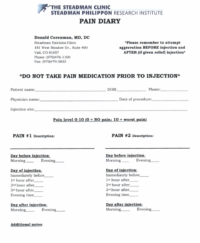Pain Diary Instructions
The injection into the spinal area contains two medications, a numbing agent like Novocaine and a corticosteroid. Whether you know it or not, you may have had a diagnostic type numbing injection before. When you go to the dentist, most likely you have had an injection into the jaw to numb the area that the dentist is going to work on. He is blocking the sensory nerve to the jaw. This is the exact same experience you should have with an injection into an area of the spine.
The spine is populated by pain nerves (nociceptors) and contains the actual nerve roots. Each of these can cause pain. The purpose of the diagnostic pain injection is to temporarily anesthetize (numb) the potential pain sources to prove they are the pain generators. Just like in the jaw, the numbing sensation lasts for 2-3 hours.
Mechanical or Temporal Pain must be present
Pain must be reliably recreated with a specific activity. If sitting for 20 minutes creates the pain, you must sit after the injection within the three hour “golden window” when the anesthetic is working. If walking for 5 minutes causes the pain- please walk to try and recreate the pain. Same thing if bending, twisting or any other activity causes the pain. Try and reproduce the pain after the numbing agent is working and record the results.
If the pain cannot be reproduced consistently with activity or is not constantly present, the injection will not reveal the source of the pain. (If the pain occurs without notice and you can identify no activity that causes it, the pain injection won’t work for the diagnosis). If your pain level is zero before the injection and zero after the injection, nothing can be learned about the pain source. Thankfully- this condition is very rare.
If you take pain medication and the pain is eliminated by the medication, do not take the medication prior to the injection. If you need pain medication to “survive” and the medication dulls but does not eliminate the pain, you can take the pain killer prior to the injection. Remember- you must be able to identify the elimination of pain through the injection to confirm the suspected pain generator. If that means stopping the pain medication, by all means- stop it.
Who does the Injection?
The technical ability of the injectionist is paramount. Let’s say by exam and MRI- leg pain could be caused by compression of either the L4 or the L5 nerve root. To test only the L4 nerve through an injection, a small amount of numbing medication would be placed only on the root itself. This is technically demanding. Too much medication will spread throughout the spinal canal and anesthetize other nerve roots causing a false positive test. (A test that falsely indicates the nerve root being tested is the painful one). On the other hand, medication that is injected but not properly placed in contact with the nerve will give a false negative test (the nerve is truly causing pain but the injection does not give relief- leaving the physician to believe that nerve is not the pain source).
If the diagnosis was not clear, you could have an operation to decompress both nerves or you could diagnose which nerve is involved by using an accurately placed selective nerve root block (SNRB) and have a much smaller operation to decompress only the painful nerve.
Immediately after the Injection
After the injection, you must get up and test the nerve. If the surgery center keeps you sedated or in bed for the 3 hours after the injection, the diagnostic portion of the block is lost along with the important information that goes along with the block. You must get up and repeat the activity that causes the pain in the next 3 hours as well as keep a record (a pain diary) of the response to the activity. If walking a block causes onset of pain, then by all means, walk. If prolonged sitting or bending or neck extension causes pain- do those maneuvers and keep a record of the pain!
Pain Diary
Pain diary instructions for spinal injects is something that a patient must understand. You need to record the level of the pain prior to the injection, for the first three hours after the injection- hour by hour and the pain in the evening of the injection. Longer term pain relief (weeks to months) is important but does not matter regarding the diagnostic part of the injection. The steroid effect will start between 12-48 hours after the injection. Steroid may affect pain away from the point of injection so longer term relief gives no information regarding the cause of pain or the structure that is being injected. If there are two painful regions (hip and back of the leg or neck and right arm), the pain diary needs to assess both locations separately. If the leg pain is caused by an inflamed nerve root and the groin pain is caused by a tear of a supporting hip ligament, the leg pain will be relieved by the injection but the hip pain won’t. If however, both groin and leg pain is temporarily relieved by the same spinal injection, the source of the pain is most likely only from the spine.
Download Pain Diary form for pain diary instructions for spinal injections
For more information on pain diary instructions for spinal injections, please contact Dr. Donald Corenman. He is available daily at the orthopedic spine surgery clinic in Vail, Colorado at 888-888-5310.
Related Articles
- Lumbar Discograms
- Cervical Discograms
- Epidural Injections and Selective Nerve Root Blocks- Diagnostic and Therapeutic
- Facet Blocks and Rhizotomies
- Diagnostic vs Therapeutic Injections
- Home Testing For Leg Weakness
- How to Describe Your History and Symptoms of Neck, Shoulder and Arm Pain
- How to Describe Your History and Symptoms of Lower Back and Leg Pain
- Walking (gait) Disorders

